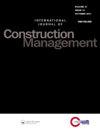基于 BIM 的板式住宅建筑排水系统自动化设计
IF 3.4
Q2 CONSTRUCTION & BUILDING TECHNOLOGY
International Journal of Construction Management
Pub Date : 2023-11-18
DOI:10.1080/15623599.2022.2085853
引用次数: 0
摘要
摘要 建筑信息模型的发展促进了板式建筑成本和时间管理的改善。本研究提出了一种在 BIM 环境中设计和起草排水系统的自动化方法。该方法可提高设计效率,消除设计错误,减少材料浪费。为了提高板式建筑工厂的生产效率,排水管网在管道穿过的楼板或墙板的几何边界处被分成较小的组件。同时,还为每块水管板生成材料清单,以便进一步优化切割。作为概念验证,开发了一个 BIM 扩展应用原型(Autodesk Revit 的一个插件)。本文还介绍了一个住宅排水系统设计和优化案例研究,以说明拟议框架的可行性。作为本研究的主要贡献,BIM 模型与自动化设计系统、基于规则的管道路径规划方法和优化切割库存算法的整合,实现了板式建筑背景下排水系统设计的自动化,从而提高了设计和生产效率。本文章由计算机程序翻译,如有差异,请以英文原文为准。
BIM-based automated design of drainage systems for panelized residential buildings
Abstract The development of building information modelling has facilitated the improvement of cost and time management in panelized construction. This research proposes an automated method to design and draft drainage systems in the BIM environment. The proposed method can improve design efficiency, eliminate design errors, and reduce material waste. In order to improve production efficiency at the panelized construction plant, the drainage pipe network is separated into smaller components at the geometric boundaries of the plumbing panel which is a floor or wall panel through which pipes pass. Meanwhile, a bill of materials for each plumbing panel is generated for the purpose of further cutting optimization. A prototyped BIM extension application, an add-on to Autodesk Revit, is developed as a proof of concept. A case study of residential drainage system design and optimization is presented to illustrate the feasibility of the proposed framework. As the key contribution of this research, the integration of the BIM model with the automated design system, rule-based pipe route planning approach, and optimal cutting stock algorithm achieves the automation in drainage system design in the context of panelized construction to improve design and production efficiency.
求助全文
通过发布文献求助,成功后即可免费获取论文全文。
去求助
来源期刊

International Journal of Construction Management
MANAGEMENT-
CiteScore
8.60
自引率
17.90%
发文量
112
期刊介绍:
The International Journal of Construction Management publishes quality papers aiming to advance the knowledge of construction management. The Journal is devoted to the publication of original research including, but not limited to the following: Sustainable Construction (Green building; Carbon emission; Waste management; Energy saving) Construction life cycle management Construction informatics (Building information modelling; Information communication technology; Virtual design and construction) Smart construction (Robotics; Artificial intelligence; 3D printing) Big data for construction Legal issues in construction Public policies for construction Building and Infrastructures Health, safety and well-being in construction Risk management in construction Disaster management and resilience Construction procurement Construction management education
 求助内容:
求助内容: 应助结果提醒方式:
应助结果提醒方式:


